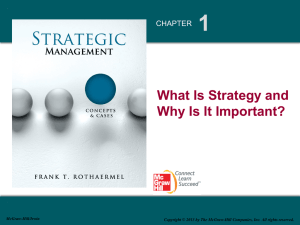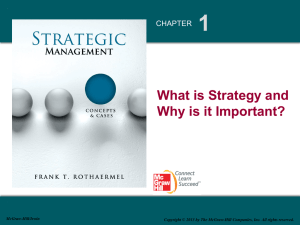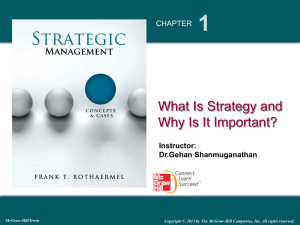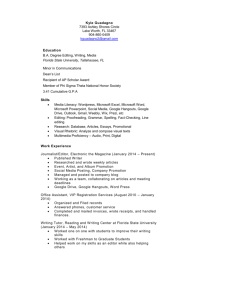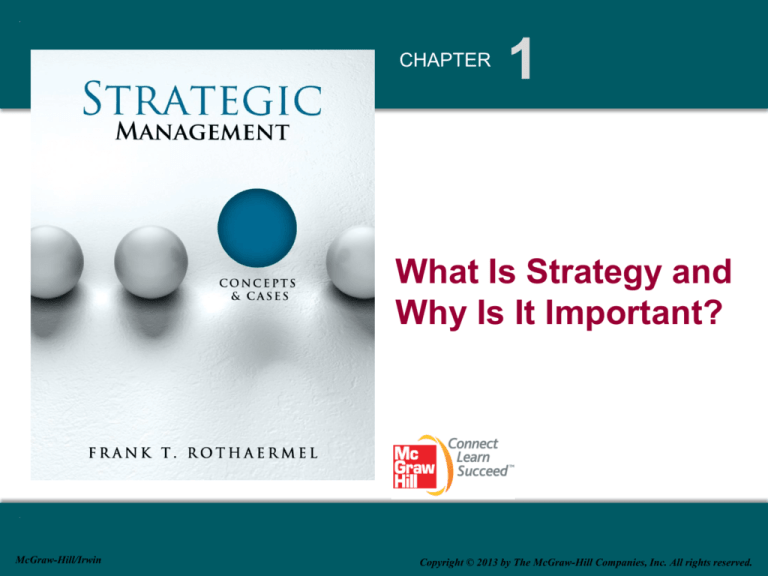
CHAPTER
1
What Is Strategy and
Why Is It Important?
McGraw-Hill/Irwin
Copyright © 2013 by The McGraw-Hill Companies, Inc. All rights reserved.
The Wisdom of Choice
•
“To try and fail is at least to learn; to fail to try is to
suffer the inestimable loss of what might have been.”
– Chester Barnard
(former CEO of New Jersey Bell Telephone)
• The Functions of the Executive
Part 1 Strategy Analysis
LO 1-1 Define competitive advantage, sustainable competitive
advantage, competitive disadvantage, and competitive parity.
LO 1-2 Define strategy and explain its role in a firm’s quest for
competitive advantage.
LO 1-3 Explain the role of firm effects and industry effects in determining
firm performance.
LO 1-4 Describe the role of corporate, business, and functional managers
in strategy formulation and implementation.
LO 1-5 Outline how business models put strategy into action.
LO 1-6 Describe and assess the opportunities and challenges managers
face in the 21st century.
LO 1-7 Critically evaluate the role that different stakeholders play in the
firm’s quest for competitive advantage.
ChapterCase 1 The Premature Death of a Google Forerunner at Microsoft
• Google founded in 1998
Two graduate students at Stanford –
Sergey Brin and Larry Page
PageRank algorithm a clear improvement
Today, it is world’s leading online search/advertising firm
• Microsoft bought LinkExchange in 1998
Keywords product for search engines; but shut down in 2000
• Microsoft considered buying Overture Services in 2003
Gates and Ballmer passed on the deal
Yahoo buys Overture -- an innovator in internet
services/advertising -- for its own search product
for $1.6 billion
• Microsoft launches its own search in 2009
Bing now strategically partnered with Yahoo
Microsoft and Google –
Online Search
• What’s happening in our chapter opener?
Why might Microsoft have acted the way it did?
If they had not killed Keywords, would Microsoft have
beat Google to search and linked ads?
Why is Google so successful at online search while
Yahoo struggled and partnered with Microsoft?
With hindsight, it appears that Microsoft made
strategic errors in 1998 and in 2003. What could they
have done differently?
What Strategy is: Gaining and Sustaining
Competitive Advantage
• What is Competitive Advantage?
Superior performance relative to competitors
Examples: Google, Pfizer’s Lipitor (patent
protection to 2010)
• What is Sustainable Competitive Advantage?
Sustainable competitive advantage occurs when a firm
implements a value-creating strategy of which other
companies are unable to duplicate the benefits or find it too
costly to imitate.
An important basis for sustainable competitive advantage
is the development of resources and capabilities.
What Strategy is: Gaining and Sustaining
Competitive Advantage
• What is Strategy?
Goal-directed actions to gain & sustain competitive advantage
It is not a zero-sum game
Win – win scenarios – co-opetition (i.e., collaborative
efforts among competitors for mutual gain)
Requires trade-offs for strategic positioning
(low cost) JCPenney vs. (upscale) Neiman Marcus
(low cost) Southwest Airlines vs. (stuck in the middle) Delta Song
Definitions of Strategy
• The term “strategy” is intended to focus on the
interdependence of the adversaries’ decisions and on
their expectations about each other’s behavior.”
(Thomas Schelling The Strategy of Conflict)
• “Strategy can be defined as the determination of the basic
long-term goals and objectives of an enterprise, and the
adoption of courses of action and the allocation of
resources necessary for carrying out those goals.”
(Alfred D. Chandler Strategy and Structure)
• Strategy is: “The pattern or plan that integrates an
organization’s major goals, policies, and action sequences
into a cohesive whole. A well formulated strategy helps to
marshal and allocate an organization’s resources into a
unique and viable posture based on its relative internal
competencies and shortcomings, anticipated changes in
the environment, and contingent moves by intelligent
opponents.” (James Brian Quinn, Logical Incrementalism)
Strategy as a Theory of How to Compete
• Provides a Manager's Roadmap
The strategic management process is a cycle of
analysis, formulation, implementation, and feedback.
Apple Newton flops in 1993
PalmPilot (Jeff Hawkins) learned from Apple
Newton’s mistakes
iPhone a huge success in 2009
Wal-mart' (Sam Walton’s) assumptions about low costs,
low prices, and high volume to drive profitability
Auto industry differences between U.S. and Japan
Palm Video
EXHIBIT 1.2
Definition:
What is Strategy?
Strategy is the quest to create, capture and
sustain competitive advantage.
• It is the managers’ theories/maps about how to gain and
sustain competitive advantage.
• It is about being different from your rivals.
• It is about creating value while containing cost.
• It is about deciding what to do, and what not to do.
• It combines a set of activities to stake out a unique position.
• It has alternatives, consequences, and choices involving significant
resources, typically made under some level of uncertainty.
• It requires long-term commitments that are not easily reversible.
Key Drivers of Value Creation and
Sustainable Competitive Advantage
• Generating economic value can be accomplished
through:
REVENUE drivers
COST drivers
RISK drivers
Value and Cost Drivers
Figure 2.5
1-13
LO 1-1 Define competitive advantage, sustainable competitive advantage,
competitive disadvantage, and competitive parity.
LO 1-2 Define strategy and explain its role in a firm’s quest for competitive
advantage.
LO 1-3 Explain the role of firm effects and industry effects in
determining firm performance.
LO 1-4 Describe the role of corporate, business, and functional
managers in strategy formulation and implementation.
LO 1-5 Outline how business models put strategy into action.
LO 1-6 Describe and assess the opportunities and challenges
managers face in the 21st century.
LO 1-7 Critically evaluate the role that different stakeholders play in the
firm’s quest for competitive advantage.
EXHIBIT 1.1
Industry, Firm, and Other Effects Explaining Superior Firm Performance
Industry vs. Firm Effects in Performance
Astute managers create superior performance
Making important trade-offs
- Toyota’s lean manufacturing
Sources of Superior Profitability
INDUSTRY
ATTRACTIVENESS
RATE OF PROFIT
ABOVE THE
COMPETITIVE
LEVEL
How do we
make
money?
Which
businesses
should we be
in?
CORPORATE
STRATEGY
COMPETITIVE
ADVANTAGE
How should
we compete?
BUSINESS
STRATEGY
16
Strategy Across the Levels
• Where to Compete?
Should GE move more
aggressively into the
health care industry?
• How to Compete?
Should GE jet engines
• CORPORATE
STRATEGY
• BUSINESS
STRATEGY
have better fuel efficiency
than Rolls Royce?
• How to Implement?
Should GE human
resources recruit more
science graduates?
• FUNCTIONAL
STRATEGY
EXHIBIT 1.3
Strategy Formulation and Implementation Across Levels:
Corporate, Business, and Functional Strategy
Business Models
• Putting Strategy into Action
"Razor-blade model" (e.g., laser printers)
Subscription model (free cell phone
along with wireless plan)
• How is the firm going to make money to
continue operations?
• What’s happening now between Microsoft
and Google?
Business models in opposite directions
EXHIBIT 1.4
Microsoft
Competing Business Models: Google vs. Microsoft
Multi-point Competition
Operating
Systems
Software
Apps
Online
Search
Google
Strategy in the 21st Century
• Accelerating Technological Change:
84 years for half of U.S. families to own a car;
28 years for half to own a TV;
19 years for the PC to reach 50% ownership;
6 years for an MP3 player.
EXHIBIT 1.5
Accelerating Speed of Technological Change
Strategy in the 21st Century
• A Truly Global World
BRIC countries have 40% of earth’s population
Brazil, Russia, India, and China
IBM has less than 30% of employees in the U.S.
“Bottom of the pyramid” business opportunities
Grameen Bank in India: Microcredit
Thomas Friedman-Flat World
EXHIBIT 1.6
Geographic Sources of IBM Revenues, 2010
Is IBM still a “U.S. company” ?
Strategy in the 21st Century
• Future Industries
Health Care
In
the U.S., over 16% of GDP and still growing
Green Economy
Potentially
large growth in energy efficiency
and technologies (e.g., solar panels)
WEB 2.0
Interactivity
and using collective intelligence on the
Internet. Subject to "network externalities"
STRATEGY HIGHLIGHT 1.1
Threadless: Leveraging Crowdsourcing
to Design Cool T-Shirts
• Online apparel company: Threadless
Started in 2000 with $1,000 by 2 students –
Jake Nickell and Jacob Dehart
“Prosumers” – a hybrid supplier/customer
Shirt designs are submitted by the community
Designs are voted on by the online community
– Only winning designs are produced & sold
– “Crowdsourcing”: volunteers for tasks
Threadless Interview
1–26
LO 1-1 Define competitive advantage, sustainable competitive advantage,
competitive disadvantage, and competitive parity.
LO 1-2 Define strategy and explain its role in a firm’s quest for competitive
advantage.
LO 1-3 Explain the role of firm effects and industry effects in determining
firm performance.
LO 1-4 Describe the role of corporate, business, and functional managers
in strategy formulation and implementation.
LO 1-5 Outline how business models put strategy into action.
LO 1-6 Describe and assess the opportunities and challenges managers
face in the 21st century.
LO 1-7 Critically evaluate the role that different stakeholders play in
the firm’s quest for competitive advantage.
Stakeholders
• Successful business generates societal value
• Stakeholders – are affected by firm’s actions
Internal
External
• Vary by industry
Autos
United Auto Workers (UAW)
Investment banking
Employees are powerful stakeholders
The Manager’s Role in Balancing Expectations
• Business Roundtable:
“Balancing the shareholder’s expectations of maximum
return against other priorities is one of the fundamental
problems confronting corporate management.”
• Understanding corporate strategy means understanding the
competing value claims of multiple stakeholders.
• Stakeholders are the individuals and groups who can affect,
and are affected by, the strategic outcomes achieved and
who have enforceable claims on a firm’s performance.
29
EXHIBIT 1.8
Internal and External Stakeholders
31
Our Learning Goals:
Pushing Down Through Bloom’s Taxonomy
1. Knowledge: remember
remember
material;
material; know
know terms,
terms, facts,
facts,
procedures,
procedures, basic
basic concepts
concepts
2. Comprehension:
grasp
grasp meaning;
meaning; understand
understand
facts,
facts, interpret
interpret charts,
charts,
translate
translate verbal
verbal to
to math
math
estimate
estimate consequences
consequences
3. Application: use
use
material
material in
in new
new situations;
situations;
apply
apply concepts
concepts to
to real
real
situations,
situations, follow
follow aa procedure
procedure
4. Analysis: break
break material
material
into
into components
components &
& understand
understand
structure;
structure; recognize
recognize logical
logical
fallacies,
fallacies, distinguish
distinguish fact
fact and
and
inference,
inference, evaluate
evaluate relevancy
relevancy of
of
data
data
5. Synthesis: integrate
integrate parts
parts
to
to make
make aa new
new whole,
whole, integrate
integrate
learning
learning to
to solve
solve aa problem
problem
6. Evaluations: judge
judge logical
logical
consistency,
consistency, judge
judge whether
whether
conclusions
conclusions are
are supported
supported by
by
facts
facts
32
Take-Away Concepts
LO 1-1 Define competitive advantage, sustainable competitive
advantage, competitive disadvantage, and competitive parity.
Competitive advantage is relative rather than absolute.
To obtain a competitive advantage, a firm must either create
more value for customers while keeping its cost comparable to
competitors, or it must provide value equivalent to competitors
but at a lower cost.
A firm dominating competitors over time has sustained
competitive advantage.
A firm that continuously underperforms its rivals or the industry
average has a competitive disadvantage.
Two or more firms that perform at the same level have
competitive parity.
Take-Away Concepts
LO 1-2 Define strategy and explain its role in a firm’s request for
competitive advantage.
Strategy can be viewed as the set of goal-directed actions a firm intends
to take in its quest to gain and sustain competitive advantage.
An effective strategy requires that strategic trade-offs be recognized
and addressed—e.g., between value creation and the costs to create
the value.
Managers’ strategic assumptions are an outflow of their theory of how
to compete. Successful strategy requires three integrative management
tasks—analysis, formulation, and implementation.
When managers align their assumptions closely with competitive
realities, they can create and implement successful strategies, resulting
in value creation and superior firm performance.
When managers’ theories about how to gain and sustain competitive
advantage do not reflect reality, their firm’s strategy will destroy rather
than create value, leading to inferior firm performance.
Take-Away Concepts
LO 1-3 Explain the role of firm effects and industry effects in
determining firm performance.
A firm’s performance is often more closely related to its managers’
actions (firm effects) than to the external circumstances surrounding it
(industry effects).
Firm and industry effects, however, are interdependent and thus both
relevant in determining firm performance.
LO 1-4
Describe the role of corporate, business, and functional
managers in strategy formulation and implementation.
Corporate executives must provide answers to the question of where to
compete (in industries, markets, and geographies), and how to create
synergies among different business units.
General (or business) managers must answer the strategic question of
how to compete in order to achieve superior performance. They must
manage and align all value chain activities for competitive advantage.
Functional managers are responsible for implementing business
strategy within a single value chain activity.
Take-Away Concepts
LO 1-5 Outline how business models put strategy into action.
A business model must translate strategy into effectively
implemented tactics and initiatives that make money for the
firm.
LO 1-6 Describe and assess the opportunities and challenges
managers face in the 21st century.
Ever-faster technological changes in a global marketplace.
Health care, green economy, and Web 2.0 are likely good
growth opportunities.
Take-Away Concepts
LO 1-7 Critically evaluate the role that different stakeholders play
in the firm’s quest for competitive advantage.
Stakeholders are individuals or groups that have a claim or interest
in the performance and continued survival of the firm; they make
specific contributions for which they expect rewards in return.
Internal stakeholders include stockholders, employees (including
executives, managers, and workers), and board members.
External stakeholders include customers, suppliers, alliance
partners, creditors, unions, communities, and governments at
various levels.
Some stakeholders are more powerful than others, and may extract
significant rewards from a firm, so much so that any firm-level
competitive advantage (from a shareholder wealth perspective)
may be negated.

